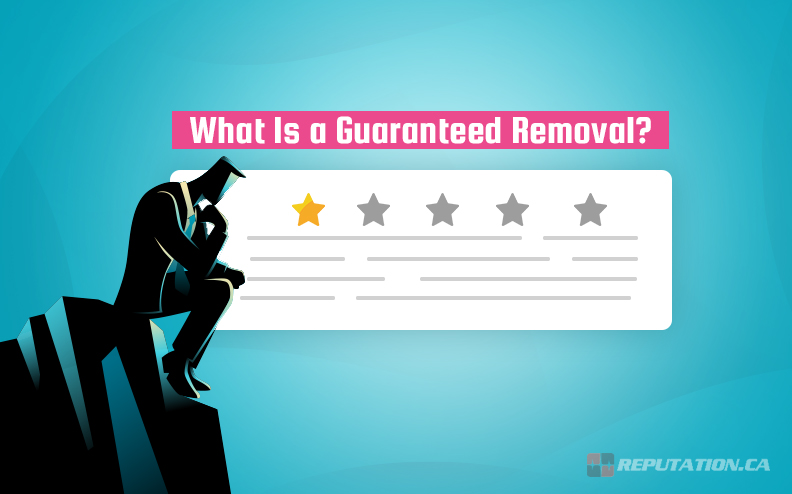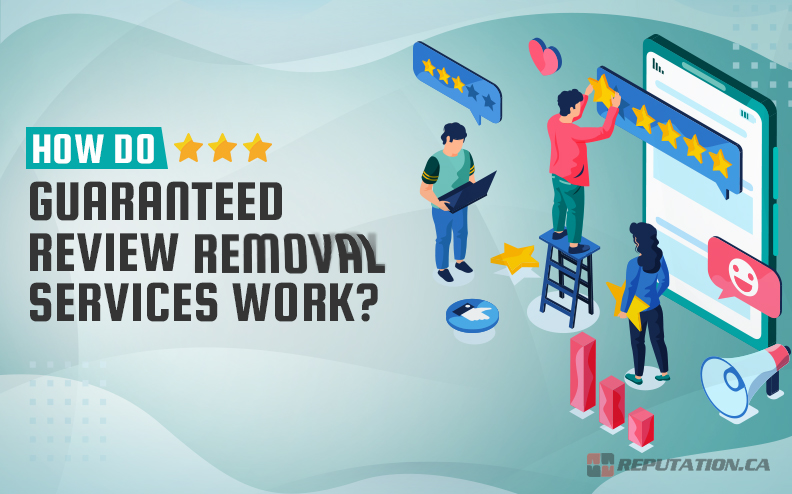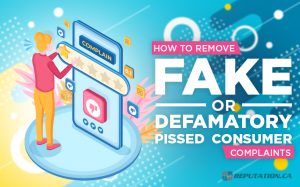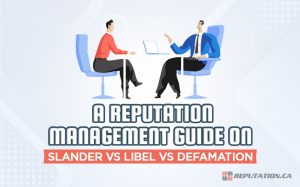One thing you might have heard of when investigating reputation management is the concept of a Guaranteed Removal. It sounds tempting; a way to have information about you or a negative listing permanently removed, guaranteed. At least, that’s what it sounds like from the name. What really is a guaranteed removal, how does it work, and are they real?
What Is a Guaranteed Removal?
A guaranteed removal is exactly what it sounds like on the tin. It’s a service that promises to remove negative content, such as reviews, from websites online. The websites might be social media, storefronts like Amazon, or review aggregators like Yelp or TrustPilot.

Guaranteed removals fall into a few different categories.
- True. ‘True’ guaranteed removals are promises that can be kept. In the case of negative reviews that are fraudulent or falsified, they can be removed without issue, and the promise of a guaranteed removal is upheld.
- Plausible. Plausible guaranteed removals are usually either large-scale campaigns or campaigns to get negative content removed from sites that sometimes, but not always, remove content. Bear in mind that some review sites simply refuse to remove reviews, so a guaranteed removal is not always possible.
- Unlikely. Sometimes, negative reviews are so widespread or are hosted on sites that don’t remove reviews and thus become extremely difficult or expensive to remove. Certain dedicated reputation management companies might be able to get the reviews removed, but many cannot.
- False. False guaranteed removals are a promise made by reputation management firms that absolutely cannot be upheld. This might be because of the nature of the content, or the nature of the sites hosting it, or just the sheer volume of sites hosting it. These sites “do their best” and then either ghost the client, or offer a mere partial refund for their guarantee.
The “guarantee” in a guaranteed removal is a two-part deal. Either the negative reviews or content is removed successfully, or the client gets their money back.

Often, a reputation management firm offering a guaranteed removal service will pro-rate their pricing. The more widespread, more difficult, or more pervasive the negative reviews they need to remove, the higher the pricing. If they can’t remove all of it, they’ll still charge you for the reviews and content removed, but refund you for what they can’t remove.
Guaranteed removals are also usually aimed at content that is false, or aimed at “shaming” the client. For example, sites like Cheaterland.com and TheDirty.com exist to shame primarily women and are used for harassment campaigns, slander, and general misogyny. Getting content removed from those kinds of sites is often a matter of legal action, and while it can be effective, it’s often tricky to navigate if you’re not experienced at doing so.
How Guaranteed Removals Work
The actual process for a guaranteed removal can vary from company to company but generally follows a consistent framework.

The first step is for the company to assess what kind of content needs to be removed. Some kinds of content can be removed, such as:
- Shaming content, such as the content on the sites mentioned above.
- Slanderous content, including falsified records and made-up stories.
- Revenge porn and other content posted without permission.
- Falsified negative reviews.
On the other hand, some kinds of content cannot be as easily removed, such as:
- Legitimate negative reviews.
- Criminal records that have not been sealed or expunged.
- Knowledge of public interest, such as participation in legal issues or public events.
Of critical importance here is the nature of the content. False and fake content can be removed under the threat of legal action over slander or libel, and content that was posted without permission (like revenge porn) can be removed, in part due to the increasing body of law against it.
On the other hand, content that is legitimate, such as negative reviews left in good faith and with accurate information attached, is usually not removable. Some review sites will allow for the removal of some such content, but many do not.
Once the content has been assessed, the company will offer a rundown of what content needs to be removed, whether or not it can be removed, and a price for that removal. The price may vary a lot depending on the kind of content, the company doing the removal, and whether or not the reputation management firm has a prior relationship with the site hosting the content. The price can be influenced by several factors, such as:
- The volume of content that needs to be removed. A single post on a single website can be removed much more easily than a post that has been syndicated across dozens or hundreds of sites, or hundreds of negative reviews across dozens of review aggregators. Remember, as well, that many sites hosting negative content online scrape it from each other, and are not first-party sources of information. Large volumes of content might be more expensive to remove, but bulk removals might elicit a discount.
- The sites hosting the content. Some sites have established processes for removing falsified content and will happily do so when notified. Others will fight until it is proven that the content is false. Others are extortionate and demand removal fees. Still, others simply ignore requests for the removal of content until a legal threat is imminent. The harder it is to remove content, the more expensive it is.
- Where the content is hosted. Many sites that host illegal or defamatory content these days are hosted and operated out of countries that typically do not regulate or care about the web servers in their country. Eastern Europe in particular is common. The simple act of contacting these sites can be extremely difficult, and removing the content with anything short of international legal proceedings is impossible, so it’s much more expensive to remove the content.
- Whether or not an attorney is involved. If removing content is as simple as filling out forms or sending an email to a web host, it’s a lot cheaper than if a threat letter needs to be drafted or, in extreme cases, a legal battle must be pursued.
- If the original poster of the content needs to be identified. Starting legal action against an anonymous poster and getting a court to order the identification of that poster is very complicated and, thus, expensive.
- The extent of the guarantee. How much effort will the reputation management firm put in before they throw in the towel and honor their guarantee? Do they pay back the money in full or in part? This varies from company to company.

Every reputation management firm that offers guaranteed removals has its own weight and value assigned to each of these, and the price they charge depends on all of it combined.
Once the price has been paid, the reputation management firm will begin to take action. A guaranteed removal may have several phases.
First, the company will reach out to the site hosting the negative content and ask that it be removed. If the site has an established process for reporting and removal of existing content, that process will be used.
If the content is not removed, the next step is typically a threat letter. These letters, typically are “form letters” drafted by a lawyer who specializes in the removal of negative content and lays out the potential threat incoming if the site does not remove the content. This can range from filing DMCA takedowns to pursuing legal action for slander.
If the content is not removed upon legal threat, the next step is to pursue legal action. Depending on the strength of the case, the reputation management firm might do this, or might not. This largely depends on the content, the firm, and whether or not they have lawyers on staff or working with them. Legal battles can be time-consuming, expensive, and can even have the inverse effect of spreading the negative content further through the Streisand Effect.

Once you’ve reached the point of legal action, suppressing information is no longer applicable. Typically, going through a lawsuit is a process to legally prove that the information is false, not hide it because the legal proceedings themselves broadcast the information to the world. This becomes an entirely different issue and may require more personalized solutions.
The Problem with Guaranteed Removals
There are, unfortunately, several problems with guaranteed removals. There’s a reason why many reputation management firms don’t offer them.
First of all, it’s often impossible to actually guarantee the removal of content online. Websites are under no obligation to remove content unless it is in violation of the law, and for negative reviews to be in violation of the law, they must be slanderous and falsified. In order to prove this, you often need a legal case to present, and that’s time-consuming, expensive, and difficult.
Secondly, takedowns do not apply to the information, they apply to the site and the individual post. At any point, anyone else can post the same information on another site, and then you have to go through the entire process again to get the content removed from another site. If you’ve set forth legal precedent, it can be easier the second time around, but it’s still often expensive and time-consuming. You may be able to file an injunction against individuals to keep them from posting the information again, but others are not beholden to it.
When you’re spending hundreds or thousands of dollars to remove a single post, only to find that post popping up on a dozen more sites as soon as it gets removed from one, you might find that the removal process isn’t worth pursuing.

And again, it cannot be stressed enough: negative reviews and other negative content can only really be removed from the web when it is in violation of a law, is slanderous, or is otherwise false. If you’re simply trying to remove negative reviews about your company that have a basis in truth, there are no grounds for removal that you can use.
What To Do Instead
Since guaranteed removals are often anything but, you have to consider alternatives. If you can’t remove negative content, the next best thing to do is flood it out with positive content.
A large part of modern reputation management is not the removal of negative content, but its suppression. Make it harder to find and less trustworthy, so it has less of an impact on your brand. You can typically do this through a combination of dedicated information campaigns, social media campaigns, review solicitation, and other reputation management techniques. As an added bonus, these techniques are often cheaper than information removal, though they may be ongoing costs.
And, of course, if negative reviews are based on fact, it’s worthwhile to investigate where those reviews are coming from and address the source. If you get a lot of negative reviews for a product not functioning as described, either the description or the product should be changed. If you have issues with shipping, change shipping methods. If you have issues with customer service or ethical business practices, or with any other aspect of your brand under your control, change those elements to be more agreeable to the public.

The best way to suppress negative information online is to remove the reason why that negative information exists. That way, you can address the negative reviews, mention how you’ve addressed the problem, and encourage disgruntled former customers to reach out for compensation.
Should You Pursue a Guaranteed Removal?
In almost all cases, the answer is no, you should not bother with a guaranteed removal service. While it might sound like an ideal case (getting content removed or your money back sounds great), chances are good that you’ll end up paying more for fewer results than a traditional reputation management campaign.

In many cases, your first contact with a reputation management firm like us should be an honest assessment of your situation and the techniques that can be used to handle it. In all but the most extreme cases, guaranteed removals are unlikely to be effective, and other reputation management techniques will have better results. Still, the choice is yours.











